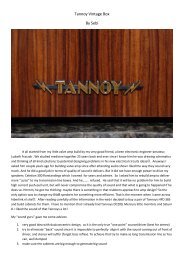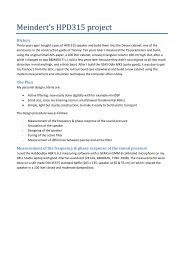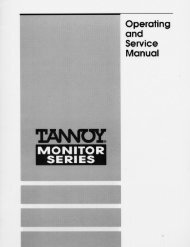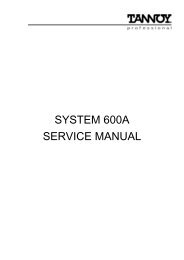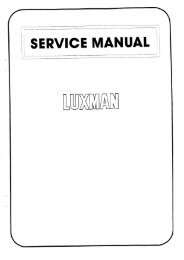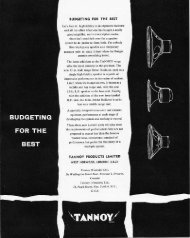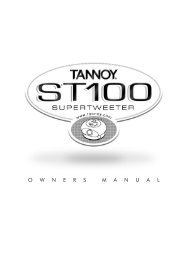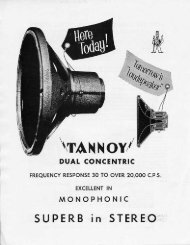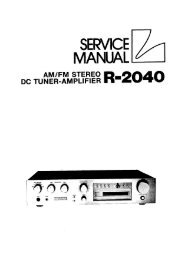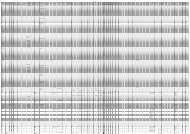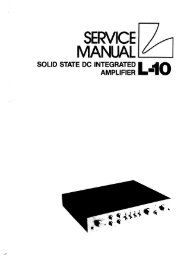Sound Practice - horn article (PDF format)
Sound Practice - horn article (PDF format)
Sound Practice - horn article (PDF format)
Create successful ePaper yourself
Turn your PDF publications into a flip-book with our unique Google optimized e-Paper software.
A Homebrew<br />
HORN<br />
for<br />
Dual Concentric<br />
Loudspeakers<br />
by R OY HILSLEY<br />
loaded HF unit concentrically mounted within<br />
a large bass driver. They were made in three<br />
f rame sizes:ten inch (called III LZ),twelve inch<br />
and a mighty fifteen inch unit and were supplied<br />
with a separate crossover. Tannoy units<br />
could be mounted in <strong>horn</strong> loaded or reflex cabinets<br />
and plans were available from Ta n n o y.M y<br />
father bought two III LZ drivers for a <strong>horn</strong><br />
loaded speaker project. U n f o r t u n a t e ,he l y never<br />
got ‘round to building those speakers.<br />
Many years passed and when I cleared out the<br />
old house, I came across these drivers and they<br />
captured my imagination. Those old units<br />
looked like new and yet were over 35 years old,<br />
but somehow the design looked right with the<br />
pepper pot drillings at the throat of the HF<br />
<strong>horn</strong> and the substantial cast fra m e.<br />
I was at the start of the trail of audio simplicity<br />
and rebirth. I had owned typical hi-end British<br />
made transistor based hi-fi for many years and<br />
was listening to inefficient milti-driver speakers.<br />
They were, h o w e v e r, lifeless and had no<br />
Reviving a 1960s classic…<br />
I consider myself to be very lucky. My father<br />
introduced me to hi-fi when I was a teenager.<br />
That was over forty years ago! In those days<br />
audio electronics and hi-fi was very much an<br />
e x p e r i m e n t e s r hobby ’ and my father loved to<br />
put electronic components together to make all<br />
manner of things. He built our amps, tuner and<br />
speakers—first for mono and then stereo. H e<br />
even built our first TV set!<br />
The early hi-fi shows in England were held at<br />
the Hotel Russell in London and we would visit<br />
to look, see and hear the latest audio innovat<br />
i o n s. My father was a music lover and could<br />
play the piano. He knew what sounded natura<br />
l .At one of the shows he was so impressed<br />
with the sound made by one particular manufacturer<br />
that he ordered a pair of the speakers<br />
at the show. They were Lowther A c o u s t a s<br />
(with PM6A magnets). These little gems were<br />
fast and very dynamic and we lived with them<br />
for several years but Dad always complained<br />
that they lacked really deep bass.<br />
We fired them up with a Beam Echo pre-amp<br />
and a home brew Mullard 5-10 amp.This wa s<br />
a push pull EL84 ultra linear design. G r e a t<br />
sounding design (based on the Leak Stereo 20)<br />
which he used with these speakers for severa l<br />
years until the Lowther surrounds deteriora t e d<br />
and he got fed up with adjusting the magnet to<br />
prevent periodic voice coil interference.<br />
He was by then firmly committed to the sound<br />
of <strong>horn</strong>s and he decided to try another<br />
approach using Tannoy dual concentric drive<br />
u n i t s. These very novel speakers have a <strong>horn</strong><br />
40 SOUND PRACTICES - Issue 17
d y n a m i c . sYe s, I am sorry to say that I had<br />
become a victim of the press hype.<br />
Dad had managed to collect all sorts of audio<br />
“ j u n k ”over the years and during the course of<br />
t rading this at a vintage audio store in the UK I<br />
discovered that the industry was being revolutionized<br />
by the experimental amateurs again.<br />
Valves were back. Minimalist SE designs were<br />
a d v o c a t e d .Horns were being rediscovered. I<br />
discovered <strong>Sound</strong> <strong>Practice</strong>s.<br />
I started using a modern push pull valve amp<br />
for a while and then decided to build a pair of<br />
SE amps to my own design, 4 1 7 A ,6 J 5 G T<br />
t ransformer coupled to a VAIC 300B. N e x t<br />
came a home brew phono pre-amp (similar to<br />
the Siren Song) and what joy. The tra n s i t i o n<br />
from high feedback transistor designs to no<br />
feedback valve designs revitalized my record<br />
collection and gave me so much more music<br />
and much more pleasure.The fun I had making<br />
changes then listening and making changes<br />
a g a i n .<br />
After a while I became satisfied with the amps<br />
and I decided to try <strong>horn</strong> speakers. I started by<br />
trying a vintage pair of Lowther A c o u s t a . sI<br />
loved the speed and life but soon became dissatisfied<br />
with the bass.<br />
I decided to take up the project which my<br />
father had not managed to complete. I studied<br />
plans for the Acousta published in S P and I<br />
looked at the cross sectional plans of the wellrespected<br />
Tannoy GRF enclosure published in<br />
old copies of H i - Fi News.These designs gave me<br />
some ideas.<br />
I wanted the efficiency and projection of <strong>horn</strong><br />
l o a d i n g ,but with deeper bass, but I also wa n t e d<br />
the cabinets to be dimensionally acceptable and<br />
wife friendly! The ideas crystallized into the<br />
cabinet shown in the photograph and illustra t-<br />
ed in the sketch plans. The design is not theoretically<br />
founded on a particular <strong>horn</strong> flare. I<br />
adopted an empirical approach. I listened to,<br />
studied and measured other <strong>horn</strong>s and based<br />
my design on what might look right and work.<br />
The plans are given as a basis for you to try a<br />
simple-to-build <strong>horn</strong> enclosure for Tannoy dual<br />
concentric units. You are free to experiment<br />
and improve or modify.<br />
Cut the wood to the sizes shown. I used<br />
veneered plywood. There are two cabinet<br />
widths possible. One for the ten inch units and<br />
another for the twelve inch units.Assemble the<br />
t o p, b o t t o m ,rear and inner panels to a side<br />
p a n e l .I used a “ f i l l e r ”type of fast-setting mastic<br />
g l u e. Do not glue the front baffle and remember<br />
to run internal speaker wires.<br />
Make sure that the <strong>horn</strong> is airtight. Make the<br />
bass <strong>horn</strong> throat about half of the area of the<br />
bass cone. Glue liberally and smooth internal<br />
folds with glass paper (sand paper)as well as<br />
you can before you fix the second side panel.<br />
Make the front panel baffle airtight by using a<br />
gasket made of thin felt glued to the internal<br />
b a t t e n .Screw the baffle to the internal batten<br />
with about eight brass countersunk wood<br />
s c r e w s. Fit the crossover in the space shown on<br />
the plan. When construction is complete, s a n d<br />
down all external surfaces,oil and polish to suit.<br />
When the glue is set and the polishing done fire<br />
them up—you will not be disappointed! Yo u<br />
should be listening to deep tuneful bass with a<br />
solid image and good projection. The Ta n n o y<br />
HF <strong>horn</strong> will give you a clean midrange and top<br />
end projection. These speakers are efficient so<br />
you can drive them with your 10 watt or so<br />
valve amps.<br />
In comparison to the A c o u s t a , syou will hear<br />
deeper bass without the characteristic mild<br />
“ h o n k ”which I think the Lowther cabinets<br />
h av e.These Tannoy <strong>horn</strong> speakers have less of a<br />
“hot seat” stage as an added benefit. They are<br />
not particularly sensitive in respect of placement<br />
and I turn them in just a little and use<br />
them about a foot from the wall for best effect<br />
in my room.<br />
Issue 17 - SOUND PRACTICES 41
42 SOUND PRACTICES - Issue 17
Tanno y “Monitor Gold” Specifications<br />
“FIFTEEN” “TWELVE” “III LZ”<br />
Issue 17 - SOUND PRACTICES 43



